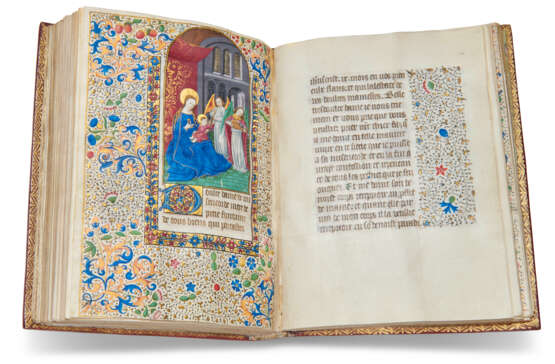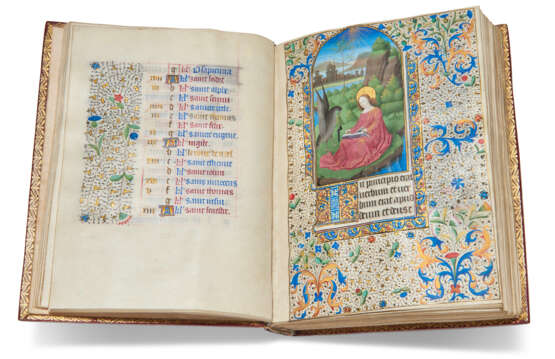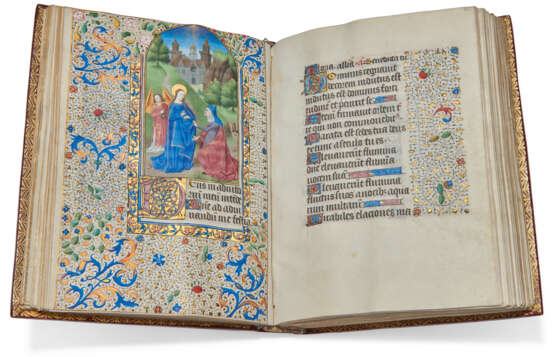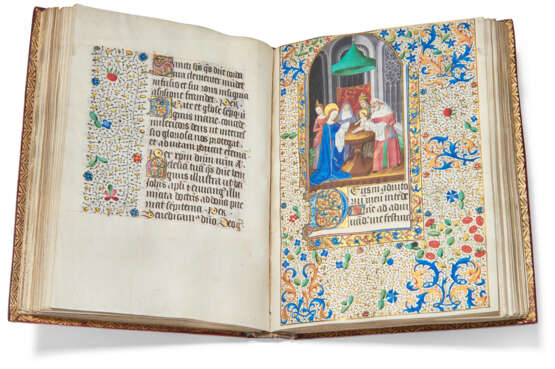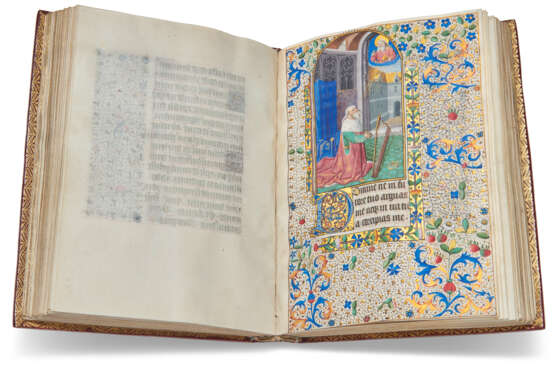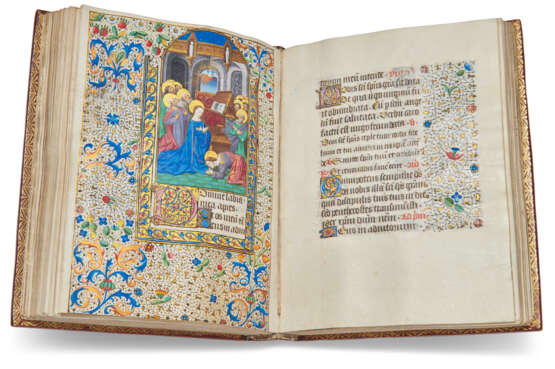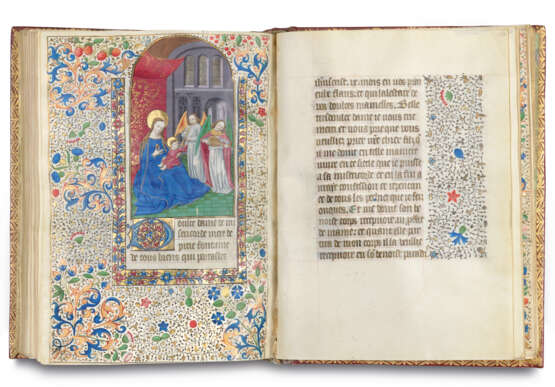ID 990554
Los 14 | Master of Jean Rolin (active 1445-65)
Schätzwert
£ 200 000 – 300 000
Book of Hours, use of Paris, in Latin and French, illuminated manuscript on vellum [Paris, c.1450-1460]
A grand, richly-illuminated Book of Hours painted by the Master of Jean Rolin, named for a missal produced for the Burgundian cardinal-bishop of Autun. An elegant masterpiece by an artist whose work heralded a new style of Parisian illumination in the mid-15th century, from the same noble collection as the ‘Tilliot Hours’ held by the British Library (Yates Thompson MS.5).
195 x 145mm. iv (paper) + 175 + iv (paper) leaves, complete, collation: 112, 26(of 8, vii-viii cancelled blanks), 3-98, 1010, 11-178, 1810, 198+1, 20-218, occasional traces of catchwords, modern pencil foliation (omitting f.122), 16 lines in two or more hands, ruled space: 110 x 62mm, rubrics in red, line fillers in red, blue and liquid gold, one-line versal initials in burnished gold on blue and red grounds and two-line initials in red and blue on burnished gold grounds infilled with foliate decoration throughout, every text page with panel borders of ivy leaves, bezants, acanthus sprays and flowers on hairline tendrils, 16 large arch-topped miniatures above large initials and one large historiated initial (5 lines) with gold baguette frames on three sides all within full borders as before (margins quite closely cropped, occasionally touching the borders, instances of light thumbing to the borders, but in excellent condition overall). Bound in late-17th or early-18th-century French red morocco janseniste, five raised bands, gilt lettered ‘HEURES CHREST’ in the second compartment, edges gilt, embossed gold brocade endpapers with hand-painted flowers (capitals restored, lightly worn at edges and corners). Modern box.
Provenance:
(1) Written and illuminated in Paris. The text is for the use of Paris throughout; St Geneviève is in the Calendar and St Denis, both venerated in the city, appear in gold; both are in the Litany. The only Memorial in the text – to St Barbara – is found in the final portion of the manuscript, ff.160-175, which may have been added at the request of the original commissioner: it contains a selection of additional prayers and may have been illuminated in another workshop.
(2) Jean-Bénigne Lucotte du Tilliot (1668-1750): his ownership inscription on f.1 (‘Ex Musaeo du Tilliot, Anno 1715’). The antiquarian and author of the Mémoires pour servir à l'histoire de la fête des fous (1741) – which traced the history of the Festival of Fools as celebrated in his native Dijon – Lucotte du Tilliot counted a number of important manuscripts among his collections, including a splendid Book of Hours illuminated by Jean Pichore now held at the British Library (the ‘Tilliot Hours’; Yates Thompson MS.5).
(3) Christie’s, 17 July 1985, lot 296.
(4) ‘The estate of the late Frank Hammond’, Sotheby’s, 17 June 1997, lot 74.
(5) Heribert Tenschert, Leuchtendes Mittelalter III, catalogue 45, 2000, no 9, where acquired.
Content:
Calendar, in French ff.1-12; Gospel Sequences ff.13-18; Obsecro te ff.19-22v; O intemerata ff.22v-26; Hours of the Virgin, use of Paris ff.27-84: matins f.27, lauds f.49v, prime f.59, terce f.64, sext f.67v, none f.71, vespers f.74v, compline f.80; Seven Penitential Psalms and Litany ff.85-100; Hours of the Cross ff.101-104; Hours of the Holy Spirit ff.104v-107; ruled blank f.108; Office of the Dead, use of Paris ff.109-150; Prayers in French ff.150v-161v: Fifteen Joys of the Virgin f.150v, Seven Requests of our Lord f.156v, Saincte vraie croix f.159v; Suffrage to St Barbara and further prayers ff.160-175.
Illumination:
This elegant Book of Hours is richly illuminated throughout: in addition to its sumptuous miniatures, every text page is adorned with a panel border and surrounded by large margins of pristine vellum. The sixteen large miniatures were painted by the Master of Jean Rolin, one of the most influential and innovative artists working in Paris in the mid-15th century. Along with the Master of Jacques de Besançon and Maître François, the Master of Jean Rolin was one of three successive illuminators through whose work – highly admired and widely emulated – we can trace the prevalent style of illumination in Paris in the second half of the 15th century. Most of the prestigious commissions from the court and leading ecclesiastics were fulfilled by this trio, who painted luxurious manuscripts for Charles VIII, Anne of Brittany, Louis XII and Henry VII of England (see Avril & Reynaud, Les manuscrits à peintures en France, 1993, pp.38-52 and 256-262).
The Master of Jean Rolin was the first of the three, active between 1445 and 1465; his influence was particularly instrumental in shaping the style of Maître François, who went on to produce a considerable number of Books of Hours for the burgeoning commercial market in Paris in the latter half of the century. Named for a missal produced c.1450-55 for the cardinal-bishop of Autun, Jean Rolin (Lyon, Bib. Mun., MS. 517), the Master’s work was positioned on a cusp, poised between the elegant stylisations of the previous generation and the more naturalistic style that would come to dominate Parisian illumination. Certain of the compositions in our Book of Hours reflect the enduring influence in Paris of the Bedford Master, working a generation earlier – the apostle kneeling at the feet of the Virgin in our Pentecost miniature (f.104v) first appears in the Bedford Hours (London, British Library, Additional MS 18850, f. 132) – while the angel appearing before the enthroned Virgin and Child on f.19 is a Flemish motif, identified by Nicole Reynaud as an inversion of Van Eyck’s Madonna of Chancellor Rolin, painted 1435, but the Master of Jean Rolin forges his own distinctive style. His figures are expressive in their attitude in spite of a certain angularity of gesture and a preference for more linear perspective. The pair of musical angels before the Virgin and Child on f.150v are posed with particular delicacy: one puffs his cheeks with the effort of playing his flute, while the other offers a shy glance towards the Christ Child, head tilted to the side. In the Burial Service marking the opening of the Office of the Dead (f.109), the shroud-wrapped body sags with convincing weight. Also characteristic is the intense palette of saturated colours: above all, the blues, used for the Virgin’s robe throughout and in the richly toned cloth covering the throne before which David prays on f.85, as well as the golden reds and browns and a generous use of gold to highlight.
The particular appeal of our manuscript lies in its compositions full of visual detail to inspire the imagination of the viewer, with an emphasis on architectural settings. Distant cities are comprehensively rendered against the skyline, while, elsewhere, the Master’s interiors are graced by delicately leaded windows, soaring ceiling tracery and eye-catching details: the Burial Service (f.109) takes place before an ossuary whose pediment is filled with minutely rendered skulls. Comparison with another refined manuscript made for an aristocratic commissioner, the Hours of Guillaume Rolin (Saint Petersburg, National Library of Russia, Rasn. Q.v.I,9), painted by the Master for the brother of his principal patron in 1455-60, reveals the same firmly modelled figures set against intricately detailed architectural backgrounds. Of particular note are the plausible cityscapes before which the Flight into Egypt is set in the two manuscripts: the Master incorporates a galleried building in these Hours (f.74v) and a fortified gate-tower in the St Petersburg manuscript (Rasn. Q.v.I,9, f.91v). The two manuscripts also share the same miniature borders, typical of Parisian manuscripts painted in the 1450s, featuring curling acanthus sprays of blue and gold placed at the corners and centre of the borders, interspersed with gold ivy-leaves and flowers supported by hairline tendrils.
The subjects of the large miniatures are: St John on Patmos f.13; Virgin and Child enthroned f.19; Annunciation f.27; Visitation f.49v; Nativity f.59; Annunciation to the Shepherds f.64; Adoration of the Magi f.67v; Presentation in the Temple f.71; Flight into Egypt f.74v; Coronation of the Virgin f.80; David in prayer f.85; Crucifixion f.101; Pentecost f.104v; Burial Service f.109; Virgin and Child with angel musicians f.150v; the Trinity enthroned f.157v.
The small miniature of St Barbara is on f.160.
Special notice
No VAT on hammer price or buyer's premium.
| Künstler: | Maître de Jean Rolin (XV. Jahrhundert - ?) |
|---|---|
| Herkunftsort: | Westeuropa, Frankreich, Europa |
| Kategorie des Auktionshauses: | Handschriften des Mittelalters und der Renaissance |
| Künstler: | Maître de Jean Rolin (XV. Jahrhundert - ?) |
|---|---|
| Herkunftsort: | Westeuropa, Frankreich, Europa |
| Kategorie des Auktionshauses: | Handschriften des Mittelalters und der Renaissance |
| Adresse der Versteigerung |
CHRISTIE'S 8 King Street, St. James's SW1Y 6QT London Vereinigtes Königreich | |
|---|---|---|
| Vorschau |
| |
| Telefon | +44 (0)20 7839 9060 | |
| Aufgeld | see on Website | |
| Nutzungsbedingungen | Nutzungsbedingungen |
